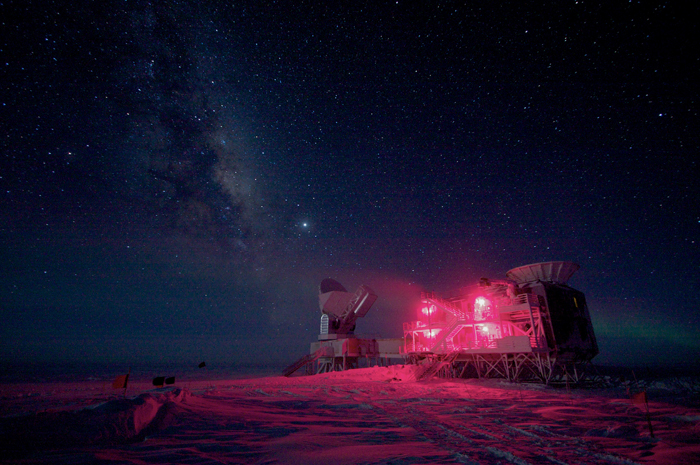The most significant news of late is the BICEP2 results – if you are unfamiliar with the result, let me first summarize the results and then offer feedback and alternative viewpoints.
BICEP2 was the second generation BICEP (Background Imaging of Cosmic Extragalactic Polarization) instrument for astronomy located at Earth’s south pole. Possessing a greatly improved focal plane transition edge sensor (TES) bolometer array of 512 sensors (256 pixels) operating at 150 GHz, this 26 cm aperture telescope replaced the BICEP1 instrument, and observed from 2010 to 2012. In March of 2014 a paper emerged suggesting that BICEP2 had detected B-modes from gravitational waves in the early universe. An announcement was made on 17 March 2014 from the Harvard–Smithsonian Center for Astrophysics.
B-mode polarization is a polarization signal in the cosmic microwave background radiation (CBR), in reference to the magnetic component of electromagnetic light in the CBR. The pattern of polarization in the cosmic microwave background can be broken into two components. One, a curl-free, gradient-only component, the E-mode (named in analogy to electrostatic fields), was first seen in 2002 by the Degree Angular Scale Interferometer (DASI). The second component is divergence-free, curl only, and is known as the B-mode.
BICEP2 researchers say that they have found the first evidence of B-mode polarization in the cosmic microwave background. (Courtesy: National Science Foundation)
Cosmologists predict two types of B-modes, the first generated during cosmic inflation shortly after the big bang, and the second generated by gravitational lensing at later times. Its believed that when the universe was very young ~ 10–35 s after the Big Bang – it underwent a period of extremely rapid expansion, ‘inflation’, when its volume increased by a factor of up to 1080 in a tiny fraction of a second. About 380,000 years after the Big Bang, the CMB – the thermal remnant of the Big Bang – was produced on the last surface of scattering, when the universe became transparent to photons. Over the years, the CMB has been measured with great accuracy, but these observations brought some problems: the CMB showed that the entire observable universe seemed to be homogeneous, flat and isotropic, while the physics of the Big Bang suggests that it should be highly curved and heterogeneous.
Further its believed that rather extreme gravitational conditions prevailed during the universe’s infancy. Gargantuan primordial gravitational waves are thought to have propagated through the universe during the first moments of inflation and this would have produced a so-called cosmic gravitational-wave background (CGB). This gravitational-wave background would, in turn, have left its own imprint on the polarization of the CMB – a sort of “curl” component or rotation that is known as the primordial B-mode polarization.
Scientists cannot distinguish between the polarization caused by gravitational waves, which has a tensor component, and that caused by density waves, which have a scalar component, by looking at the temperature variations of the CMB. It’s believed that the primordial B-mode polarization is thought to be much weaker than the E-mode, making it even more difficult to detect. However, certain measurements on the polarization angles that can be detected at each point on the sky provide extra information and allow scientists to differentiate between the tensor and scalar components, providing a “tensor-to-scalar” ratio. This ratio has been measured by BICEP2 to be 0.20 with a statistical significance of about 3σ [3 Sigma]. The possibility that the ratio is zero is ruled out with a statistical certainty of 7σ [7 Sigma]. Read the results here.
A value of 0.20 is considered to be significantly larger than that expected from previous analyses of data from the Planck and WMAP telescopes. If it’s confirmed, it is the first direct evidence not only for inflation, but of a quantum behaviour of space and time. The image of polarization is a relic imprint of roughly a single quanta of graviton action. According to the BICEP2 collaboration, its results suggest that “the long search for tensor B-modes is apparently over, and a new era of B-mode cosmology has begun”.
Sounds pretty exciting but there are some who say, maybe this is not what the BICEP team think it is:
Perimeter Institute director Neil Turok, who worked on an inflationary model of his own with Stephen Hawking in the 1990s, urges caution and says that extensive experimental confirmation is necessary before BICEP2’s results can be considered as evidence for inflation. Paul Steinhardt and Neil Turok were the two loudest critics of cosmic inflation.
Another astrophysicist Peter Coles, who is based at the University of Sussex in the UK, is also cautious about the BICEP2 data interpretations.
Theoretical physicists and cosmologists James Dent, Lawrence Krauss, and Harsh Mathur have submitted a brief paper (arXiv:1403.5166 [astro-ph.CO]) stating that, while ground breaking, the BICEP2 Collaboration findings have yet to rule out all possible non-inflation sources of the observed B-mode polarization patterns and the “surprisingly large value of r, the ratio of power in tensor modes to scalar density perturbations.â€
Sir Roger Penrose even goes as far as to suggest that the gravitational waves detected were produced pre-big bang in a previous universe and denies the existence of inflation entirely.
Whatever position you take the results are topical, but still in my mind they need further investigation as to other possible explanations. My biggest concern is that in order to suggest that the Gravitational Waves were produced by inflation, why not asked could have they been produced in the primordial universe without inflation.
Lastly, and more importantly – regardless of inflation – the detection of Gravitational Waves is additional evidence confirming Einstein’s General Theory of Relativity and that to me is the most significant result.

